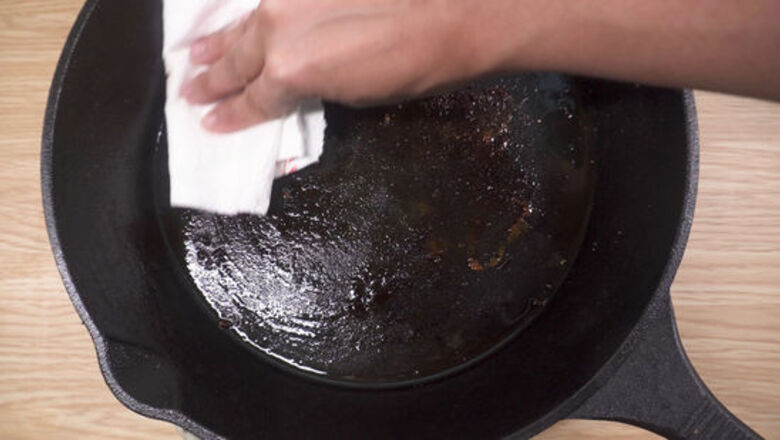
views
Giving Your Skillet a Quick Clean
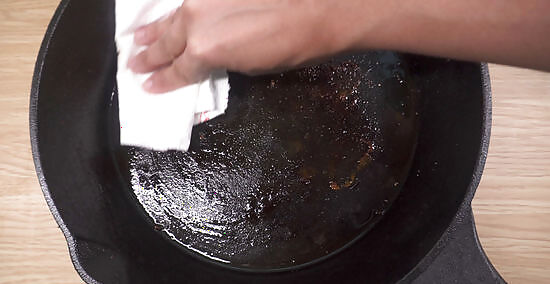
Wipe down your skillet with oil to get rid of lightly stuck food. If you catch your food just as it starts to burn to the cast iron, you may be able to clean it out with 1-2 tablespoons (15-30 mL) of oil. Pour the oil into the skillet while it is still warm and use a paper towel to wipe down the surface. Dispose of any bits of food that come loose and put your skillet away for storage. As you are using oil to clean your skillet, it should be ready for storage and prepared for the next time you want to cook with it. Use an oil with a high smoke point and a neutral taste for the best results. Vegetable oil, grapeseed oil or flaxseed oil will all work perfectly. This method will likely only work with food that's just recently burnt onto the skillet. For skillets which are seriously burnt, or which have been left for a long time, you might need to give them a more thorough clean.
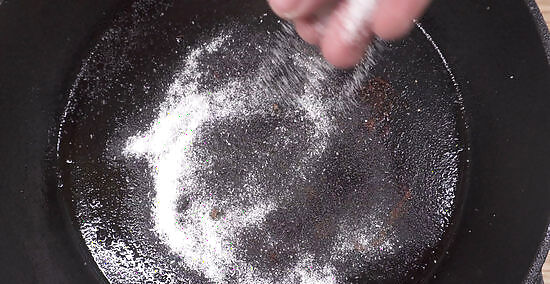
Use baking soda or salt to scrub away burnt food. Foods that were left to burn for a little longer will need something more abrasive than just oil. Scatter some kosher salt, coarse sea salt, or baking soda over the base of your skillet. Use a paper towel to begin scrubbing out any food stuck to the skillet. Give the cast iron a light rinse to remove any leftover salt or baking soda. You can use almost any coarse, abrasive powder to clean your skillet with this method. Cornmeal will work excellently in place of baking soda, but something like sugar may melt onto the surface of your skillet and give you something else to clean.
Lift away more difficult foods by boiling some water in your skillet. For food that's had more time to burn onto your skillet or left to sit, you may be able to boil it away. Fill your skillet with around 1 inch (2.5 cm) of water and place it over a medium heat. As the water begins to simmer and boil, use a wooden or plastic spoon or spatula to try and scrape away the burnt-on food. Make sure you pour the water out and left your skillet fully dry before storing it or using it again. You should only use plastic or wooden tools in your cast iron, rather than anything metal. Metal spatulas and spoons will scratch the surface and strip away the seasoning on the pan. EXPERT TIP Kadi Dulude Kadi Dulude House Cleaning Professional Kadi Dulude is a House Cleaning Professional and the Owner of Wizard of Homes, a New York City-based cleaning company. Kadi has over 10 years of experience and manages a team of over 90 registered cleaning professionals. Her cleaning advice has been featured in Architectural Digest and New York Magazine. Kadi Dulude Kadi Dulude House Cleaning Professional You can remove most burnt food by soaking the pan in water. If that doesn't work, boil water in the pan while pushing at the burnt food with a wooden spoon. If the food still isn't coming off, you can use a metal scouring pad to scrape the food. Always re-season your pan with olive oil before putting it away.
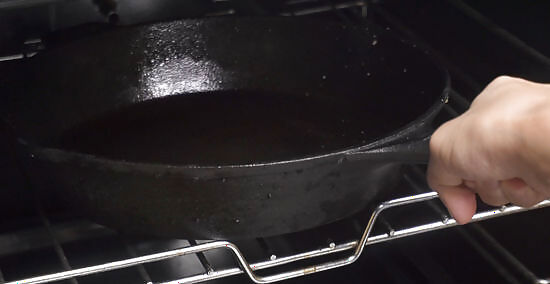
Dry your skillet in the oven. Wipe the surface of the cast iron down with a dry cloth to remove most of the excess water. Put it in a 350 °F (177 °C) oven for 10 minutes, or over a medium-high stovetop to let it completely dry. Any water left on your skillet when you put it away may cause it to start rusting. Make sure the skillet is completely dry before oiling it or storing it.
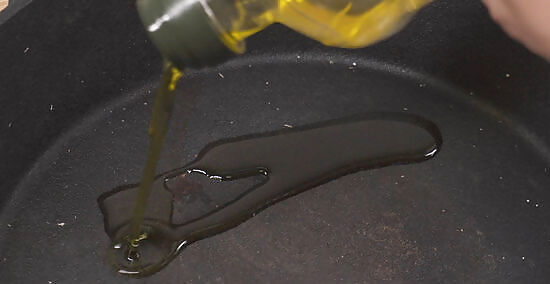
Apply a coat of oil to your skillet once you've cleaned it. You should always apply a thin layer of oil over your skillet after every time that you use it. When the cast iron is still warm, pour 1-2 tablespoons (15-30 mL) of oil into the skillet and use a paper towel to spread it all over the surface. Store your clean skillet in a dry place until you need to use it next. The oil on the warm surface of your pan will react with the cast iron to form a polymer. This is what will keep the skillet non-stick and in a great condition for a very long time. If you have already used oil to clean your skillet, you can skip this step. Choose a neutral oil with a high smoke point when seasoning your pan. Vegetable oil, flaxseed oil, and grapeseed oil will all work excellently.
Restoring and Seasoning Your Skillet
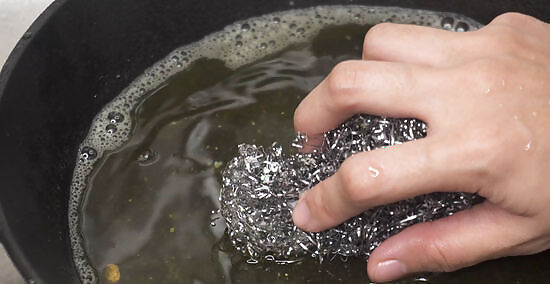
Use steel wool to scrub your skillet clean. If you can't clean your skillet any other way, you can use steel wool to strip it back to new cast iron. Pour a little warm water and dish soap into the skillet and begin scrubbing with a small ball of steel wool. Keep scrubbing until you reveal the natural and unfinished cast iron, which will have a blue-gray color to it. Some sources may tell you to never use steel wool and soap on a cast iron skillet. For a day to day clean, this is good advice, but it is essential when stripping and seasoning a skillet.
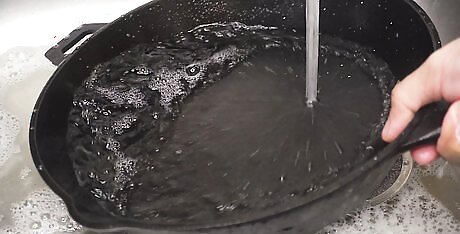
Clean the skillet with soap and hot water. Use a damp cloth to clean out the inside of your skillet until the water runs completely clear. Give the surface of the cast iron a light wash to remove any remaining rust or particles left by the steel wool.
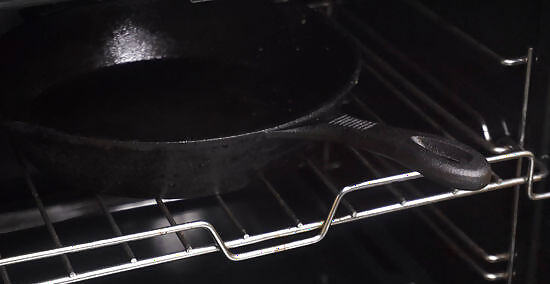
Put the skillet in a hot oven to dry it. Preheat your oven to 350 °F (177 °C). Use a clean, dry cloth to wipe away any leftover moisture on the surface of your skillet, before putting it in the oven to dry completely. After 10 minutes, take the skillet out of the oven and place it on a thick tea towel to keep it from directly touching your work surface. You can also dry your skillet on the stove. Place it over a medium-high heat for around 10 minutes, or until all the water has evaporated and the skillet is dry.
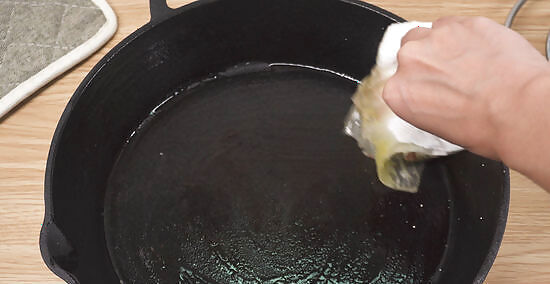
Oil the skillet all over. Use a neutral oil with a high smoke point to season your cast iron. Pour 1-2 tablespoons (15-30 mL) of vegetable, grapeseed, or flax oil into the skillet and spread it all over the surface with a paper towel. Once the skillet is covered, use another paper towel to wipe away any excess oil. Cast iron is porous, which means there are small holes all over the surface that will absorb the oil and result in a smooth cooking surface. If you leave too much oil on the skillet, it may become sticky as you cook with it.
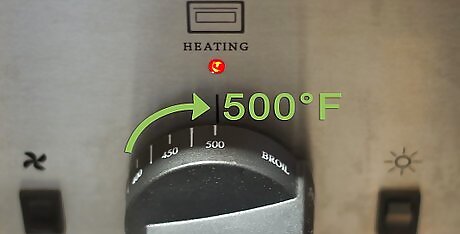
Put the skillet in your oven at around 500 °F (260 °C) for 1 hour. Turn your oven onto the highest heat that it can go and place a piece of tin foil on the lowest rack. Put your cast iron skillet upside down on the highest rack and leave it to cook for around 1 hour. This will help seal in the oil and season your skillet. The tin foil will catch any excess oil that comes off the skillet as it cooks. It's much easier to throw away a piece of foil than it is cleaning your oven!
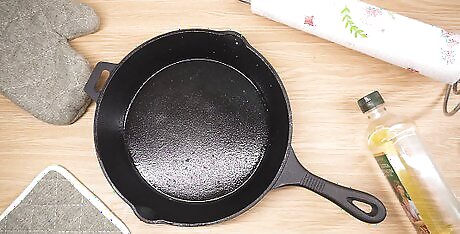
Let the pan cool and repeat the seasoning process. After an hour, turn your oven off and let the cast iron skillet cool down. It should be cleaned, seasoned and ready to use. However, for the best results, you should oil and bake your skillet once or twice more. This will build up the coating of oil even further and make your cast iron last even longer. Store your skillet in a clean and dry place. Cast iron tends to rust very quickly, so make sure to keep it away from as much moisture as you can.


















Comments
0 comment